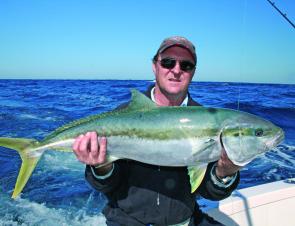The estuary system is alive at the moment, the water temperature has risen and all manner of species are eager to attack baits and lures.
Flathead action has been exceptional over the past month with plenty of duskies right through out the bay. Larger females are in full breeding mode and are accompanied by smaller males and both can be easy targets on lures and baits.
Most of my flathead fishing is done using soft plastics in depths from 1m to 5m. I find the plastics allow me to cover those varying depths simply by changing the weight of the jig head.
As a rule of thumb I find that 1/4oz heads with 2/0 to 4/0 hooks are a happy medium and any plastics with large paddle tails to create movement are perfect.
Don’t be afraid to cast those lures right up against structure like rock walls, weed beds and oyster racks; most of my larger flathead have come close to these structures.
Bream fishing is always on the cards at this time of year, with most fish spreading through out the bay. The vast flats and oyster racks towards the back of the bay, especially around Tilligerry Creek and the Karuah River, have been holding good numbers of quality bream over a kilo.
If you’re a bait angler then fresh is best. Live nippers cast alongside an oyster rack at high tide will surely be pounced on the minute they hit the water. Larger peeled green prawns will also do well, just ensure you use fluorocarbon leader with little or no weight.
Surface lures can account for some spectacular action from now until early autumn. Already some sizeable bream have taken a liking to my surface lures, some of which have been souvenired. It pays to use 10lb to 14lb fluorocarbon leaders to avoid losing too many fish and lures, especially among those shallow, oyster-encrusted areas that bream love.
Sand whiting have started taking small clear poppers blooped aggressively across the weed and sand flats at high tide.
Many bream and whiting will be lurking right in the shallows in gaps and pockets beneath the mangroves.
Bait anglers should try live beach or bloodworms. Areas such as the sand flats at Jimmys Beach and Shoal Bay have been productive in recent months and should improve as Summer progresses. Early mornings and late afternoons are the key to success, especially as human water activity increases.
Beach fishing has been the big improvement, now that salmon numbers have thinned a little. Kidney-slapping whiting are cruising the shallow gutters and sand banks and are tempted by a wriggling beach worm wafting around. Locals also have been using 2” Gulp Worms to great effect and they can be a great alternative when the real things are hard to come by.
The lower end of Stockton Beach towards the Signa has been producing the odd school jewfish after dark with fresh tailor fillets or whole squid doing the damage.
Offshore fishing has been fantastic early morning and late afternoon. Plenty of quality snapper to 8kg are cruising the shallows at the back of Broughton Island and around the Sisters.
As the sun becomes higher during the day the reds retreat to deeper water and can be sometimes hard to tempt with bait or plastics, so it pays to fish early.
The 21-fathom reef and the Big Gibber have been producing early season trag and jewfish on live baits. These areas can be fished hard by other anglers but if you’re prepared to scout around with a good quality colour sounder you will find areas just off the edges of these main reefs that hold good fish.
Kingies will also be eager to snaffle live baits and plastics with some fish over 10kg giving anglers a work over.
Further offshore, Allmark Mountain has produced some outstanding bar cod and kingies. The only problem is trying to determine if the current is running, as it can make it long day, as I recently discovered.
Marlin action has already begun with the odd stripey and black attacking lures, live bait and skip baits on the edge of the shelf. As with any early season game fishing, it can all change from day to day with the current slowly trickling down from the north.
Signs are looking good with plenty of bait inshore and the odd mahi mahi.
Reads: 1391
Kingfish are great fun and exceptional eating, especially those from deep water like this 8kg model.

Flathead are throughout the bay at the moment and are suckers for soft plastics.




